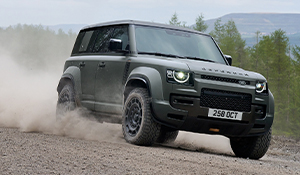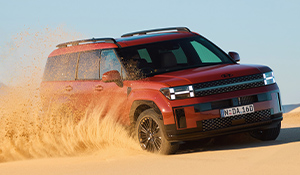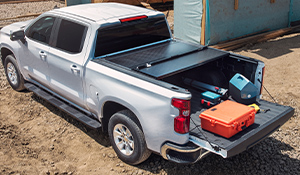FEATURE -2013 Land Rover Defender 110 TECNIQ
Words: Mike Ryan
Photos: Courtesy of Bonhams UK
What do Land Rovers have in common with Chinook helicopters? Not much, you’d probably say. And in most instances, you’d be right. Land Rovers may have been slung under the big twin-rotor cargo helicopter, and maybe one’s even been wedged inside a Chinook, too, but that’d be it. That lack of any obvious connection didn’t stop a UK company from combing the two when creating a special, one-off Land Rover Defender earlier this year.

Depending on your age, the Boeing CH-47 Chinook will evoke images of the Vietnam War, the Falklands or more recent actions in Iraq and Afghanistan. Despite these conflicts being decades apart, the Chinook has been active in all of them. Its service history goes back a long way; even beyond America’s first deployment of combat troops in Vietnam in 1965.
Developed in the late 1950s as a heavy-lift cargo helicopter by a company called Vertol, the Chinook would be built in small numbers by this firm before Boeing took over production.
While not designed purely as a military helicopter, the Chinook has nevertheless become inextricably linked with armies all over the world, including the USA, Spain, Italy, Australia, the UK, India and Japan, to name a few.
First going into service in 1962, the Chinook remains in the army and air force fleets of several nations to this day - a remarkable longevity, given military aircraft are constantly evolving and being replaced with newer and more advanced designs.

British Service
One of the long-term users of the Chinook is Britain’s Royal Air Force, who adopted the model in 1980, with its first combat deployment in the Falklands War of 1982. During that campaign, three units were on the deck of the cargo ship, MV Atlantic Conveyor, when it was struck by a missile from an Argentine Navy jet and sank. A fourth Chinook was in the air at the time of the attack, so avoided destruction and would assist in extracting survivors from the ship before going on to perform important transportation work for the duration of the Falklands campaign.
This year, to mark 40 years since that deployment, British specialty engineering company TECNIQ has built a one-off Land Rover Defender with features inspired by the long-running twin-rotor helicopter.

The TECNIQ touch
Formerly known as ADP Special Products, TECNIQ has been a leader in the design, engineering and manufacture of parts and products for the automotive industry since 1999. The rebrand to ‘TECNIQ’ was made at the start of this year.
While much of TECNIQ’s work for automotive OEMs and low volume manufacturers is high tech and cutting edge, they also operate a heritage division that specialises in the restoration and preparation of classic vehicles for historic motorsport.

Both of those business streams were called upon to create the unique Land Rover featured here, which is based on a 2013-model Defender 110 wagon.
Known as the ‘Q40 Defender by TECNIQ’ the Defender was unveiled in May, with the intention for it to be auctioned at the Goodwood Revival event in September. Reflecting its inspiration, all proceeds from the sale would go to the Royal Air Forces Association charity.
In developing this special Defender, TECNIQ worked closely with the Royal Air Force’s 18 (B) Squadron who operate Chinooks out of RAF Oldham, taking design elements from the helicopter and applying them to the exterior and interior of the Defender.

It should be noted that the Q40 Defender by TECNIQ is far from a cosmetic package, with a modernised drivetrain and improvements to the handling, technology, comfort and efficiency, too.
“The Q40 Defender project was born to celebrate all that is great about the Chinook, showcasing the latest in automotive technologies and engineering capabilities at TECNIQ and supporting the great work carried out by the Royal Air Forces Association,” said Nigel Lempriere, Chief Executive Officer and co-founder of TECNIQ, when the custom Defender as unveiled in May.

Q40 Defender by TECNIQ - outside
While still recognisably a late-model original Defender 110 from the outside, styling touches that define the Q40 Defender start with the gloss and matte dark green paint, inspired by the camouflage finish on RAF Chinooks.
Carbon fibre has been applied to the custom grille, wheelarch flares and the vents in the bonnet and front guards. The actual openings in these sections and the grille feature not the standard mesh, but a unique interlocking pattern inspired by the Chinook’s dual rotors. The same design is also used on the custom side steps.

A graphic of overlapping circles on the Defender’s flanks also hints at the twin rotors, while a decal on the tail is inspired by the badges RAF Chinook crews wear on their flying suits.
TECNIQ identification is subtly added to the front doors and front skidplate, while the door handles are bespoke and feature a tactile marine-grade leather wrap.
A gloss black finish for the headlight surrounds is continued on the wheels. The origin of these is unclear, but they’re shod with chunky BF Goodrich off-road tyres.

Q40 Defender by TECNIQ - inside
The cabin of the Defender has been consciously divided into two sections, reflecting the difference between the cockpit and cargo areas of the helicopter, but this “twin zoned” approach has been given a distinct luxury touch that’s far removed from the utilitarian innards of the Chinook!
Black trim features on the front seats and white on the rear, with the same approach taken with the doorcards. These doorcads also carry bespoke grab handles, as well as the same rotor blade design as the grille and side vents.
Carbon fibre race-style seat bases are used front and rear, with premium, hand-stitched Bridge of Weir leather upholstery combined with sheepskin inserts that are a nod to the seat trims of the Chinook.
A dark quilted headlining features over the front of the cabin, with a roof console added in the style of a Chinook that houses additional switchgear. The Land Rover’s factory steering wheel, instrument cluster and centre console have been replaced with premium components that have military influences in their design, while the gear shifter is bespoke to this vehicle.

In the second-row seating, umbrellas are housed in the seat bases, while a large chiller that sits between the two seats has space for a couple of bottles of the passengers’ preferred beverage, plus glasses and cupholders.
A white quilted headliner over the second-row seats is designed to complement the seat trim, with overhead lighting and more evidence of the twin rotor Chinook in things like the air con vents and speaker grilles for the updated infotainment system.
Behind the second-row seats, a special carbon fibre container holds a fire extinguisher, first aid kit and hazard triangle, while movement of luggage in the load area is contained by cargo webbing taken from an actual Chinook.
Finally, reflecting the fact that Chinooks often operate at night, red lighting, aka ‘submarine lighting,’ is fitted throughout the interior.

Q40 Defender by TECNIQ – mechanical
Under the skin, the Q40 Defender takes out the 2.2-litre turbodiesel four-cylinder engine that would have been standard when this 4x4 was new, replacing it with a Ford EcoBoost turbocharged 2.3-litre petrol unit from the current Mustang sports car.
TECNIQ remapped the ECU, dialling outputs down to a listed 229kW and 432Nm, instead of the 236kW and 448Nm this four-cylinder engine normally produces in the Mustang. According to TECNIQ, this is all about ensuring the Q40 Defender is as refined to drive on the road as it is capable off road.
Similarly, the Defender’s standard six-speed manual has been replaced with a modern six-speed automatic. No mention is made of the Defender’s full-time four-wheel drive system, so it can be assumed this has carried over to the TECNIQ version unchanged.
To improve ride and handling, the factory suspension has been completely replaced, with the performance of the programmable dampers, upgraded anti-roll bars, new bushings and lowered coil springs maximised by chassis tuning from TECNIQ’s Classic Racing department.
Braking’s been enhanced, too, with 345mm discs and six-piston calipers at the front, and 330mm discs with four-piston calipers at the back

To Auction
Consigned for Bonhams’ Goodwood Revival auction on 17 September, the sale of this unique Defender 110 included a tour of RAF Oldham for the winning bidder, along with entry to the RAF Club in London and even a genuine Chinook crew member’s flying suit.
Ahead of the auction, the bespoke touches and level of detailing on this one-off Defender saw Bonhams attach an estimate of £120,000 – £180,000 (AU$200,000 – AU$300,000 approx.). Ultimately, it sold for £138,000 (AU$230,460 approx.).
As mentioned, all proceeds from the sale went to the Royal Air Forces Association.
For more details from this auction, go to: bonhams.com









